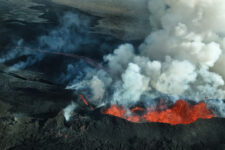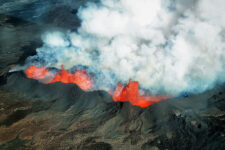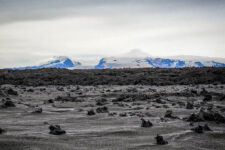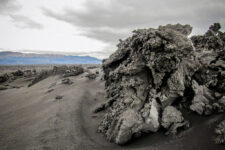The Bardarbunga (Bárðarbunga) volcano is the creator of Iceland’s newest lava field and was spewing fresh magma until a few years ago. See how it can be viewed here.
Giant volcano covered by a glacier
All of Iceland’s largest volcanoes are covered by an ice cap of glaciers and Bardarbunga is no exception. It is Iceland’s second-highest elevation and lies within the massif and under the ice cap of Vatnajokull, the largest glacier in Europe. The summit of Bardarbunga reaches 2,000 meters above sea level (according to other sources: 2009 meters above sea level), and its name could be translated as Bardur’s Hill (though, admittedly, a rather large one).
The Bardarbunga volcano is a stratovolcano. It lies at the junction of the eastern and northern volcanic rift zones and is the culmination of a huge volcanic complex. Its main caldera lies about 25 km east of the Nyidalur Valley and is as large as 8×11 km / 5×7 mi (but a total area of “only” 65 km2 / 25 sq miles). It is 700 meters / 765 yards deep and entirely filled with ice [1] [2] [5] In contrast, the volcano’s associated side fissures Veidivötn and Trollagigar extend as far as 100 km / 60 mi to the southwest and 50 km / 30 mi to the northeast. Located to the south, the Loki-Fögrufjöll volcanic system is also part of the Bardarbunga [1] system.
O
ver the past 1,000 years, the Bardarbunga volcano has erupted on average every half century [5]. The largest eruption took place about 8,500 years ago. The last one – in 2014-15. Lava field Holuhraun (85 km2 / 33 sq miles), which formed in that eruption, is still among the youngest in Iceland.
Bardarbung’s largest and most recent eruption
The Bardarbunga volcano – among other things due to its enormous size – is responsible for a great many eruptions, including in recent years. As many as 55 are currently attributed to it [1].
Bardarbung’s largest eruption took place about 8,600 years ago. Lava was then ejected from the Veidivötn fissure system and flowed to the southern coast. The volcano then produced the largest known lava flow on Earth in the past 10,000 years. More than 21 km3 of hot mass flowed from its interior, covering an area of about 900 km2 Eventually the lava flowed into the ocean, as far as 190 km / 120 mi away from the source of the outflow – near Eyrarbakki and Stokkseyri, south of today’s Selfoss [4].
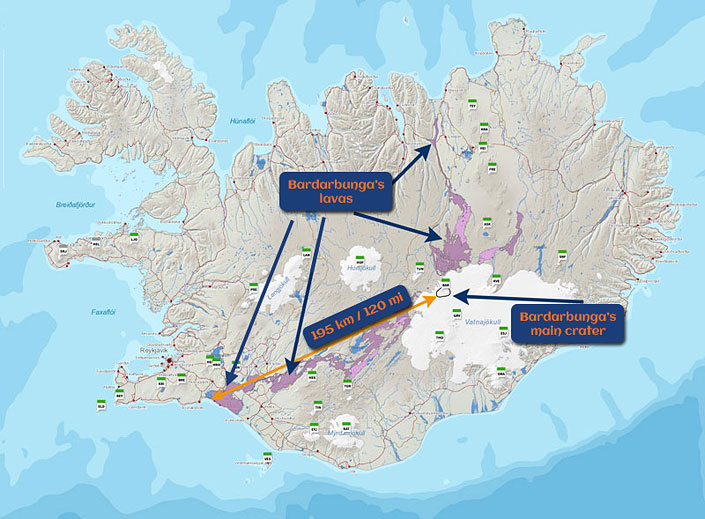
Bardarbunga volcano lava extent
Moreover – fortunately, the eruption poured lava through a side fissure, below the glacier line, and not through the main crater. As a result, the eruption also did not cause catastrophic flooding. And it was also strongly stretched out in time, and therefore less violent.
Since it end, 51 smaller tremors [3] have been recorded in the volcano area, but this is not unusual in seismically active Iceland.
Holuhraun – Iceland’s newest lava field
In contrast, the effect of the 2014-15 Bardarbung eruption was the formation of today’s Holuhraun lava field. It is located on the northern slopes of Barðarbunga, on the border of the Dyngjujökull glacier (one of the Vatnajökull tongues), about 41 kilometers northeast of the volcano’s caldera. It is not only the newest, but also the largest (85 km2) lava field formed in Iceland since 1783. The field, according to various reports, was still cooling in 2017.
However, there were no major earthquakes or crustal shifts associated with the lava flow. Although no people died as a result of the eruption, during the following year… many sheep died. The reason for this was the poisons in the soil. Toxic gases also caused respiratory problems, especially in sensitive people.
Interestingly, much closer than Bardarbunga, about 15 km from Holuhraun, is another volcano – Askja. It was the rocks from the Askja eruption (of 1797) that were covered by the recent Bardarbung eruption. Today’s Holuhraun, by the way, consists of many layers of lava that flowed into the area over the following centuries and millennia.
Due to the fact that Bardarbunga is located under the Vatnajökull glacier, the area has also been washed by glacial floods (jokulhlaup) on many occasions.
T
he original name of the area was Kvislahraun. It was not until 1884 that geologist and geographer Þorvaldur Thoroddsen gave it its current name.
How to get to Bárðarbunga
The volcano’s caldera itself lies high in the mountains and is covered by a glacier. It is difficult to get to it without using a helicopter, and walking on the glacier cover would be very dangerous.
On the other hand, you can easily drive relatively close to the volcano from the side of the valley and the Nyidalur, located almost in the middle of the interior and the entire island. Heading east from there, we can reach two parking lots – Gjosta and Svarthofdi – on the northern and southern borders of the Vonarskard lava field, respectively. This is already the area of the Bardarbunga system and the immediate vicinity of the main mountain massif.
How to get to Holuhraun
The Holuhraun lava field lies about 15 km south of the crater Askja and the Dreki hut. The F910 mountain road (the western part of this road) runs through it, which further to the west connects with the F26 road. This road offers absolutely amazing views and Iceland’s newest hot spring available for bathing, but it is very, very difficult!
The western section of the F910 is relatively short and beautiful, but any decision to drive it should be preceded by serious preparation.
Let the difficulty of the route be evidenced by the fact that it measures only about 120 km, but it takes up to 7 hours or more (sic!) to drive it. The difficulty in traversing it lies both in the fact that in many places it is narrow, steep and fraught with sharp rocks, and in other places it leads over fresh lava, where the road is practically invisible and it is very, very easy to get lost.
This section of the F910 is usually excluded from vehicle liability insurance (including off-road vehicles). It lies in an area where there is no GSM coverage and tourist traffic is minimal. It says a lot about the nature of this road that it cannot be found on Google maps… No help will come here quickly.
Although off-road driving is prohibited throughout Iceland, driving the F910 road in its western part certainly qualifies as a challenging off-road route. If you want to drive here, go in at least 2 cars, make sure you have a supply of water, food, gasoline, etc., and that you have everything you need to possibly tow your car, replace a wheel, or spend the night in your car.
Driving the eastern part of the F910 – from Dreki to Laugarfell – is another matter entirely. That part of the road will be driven without much trouble in any 4×4 vehicle.
Photos of Bardarbunga and Holuhraun
Bibliography
- https://volcano.si.edu/
- https://en.vedur.is/about-imo/news/on-the-bardarbunga-gradual-caldera-collapse
- Global Volcanism Program, 2017 Report on Bardarbunga (Iceland) (Venzke, E., ed.). Bulletin of the Global Volcanism Network, 42:2. Smithsonian Institution. https://doi.org/10.5479/si.GVP.BGVN201702-373030
- Volcanic system: the Bárðarbunga system. Edited by: Gudrún Larsen and Magnús T. Gudmundsson; Institute of Earth Sciences, University of Iceland; August 25, 2014
You can read more facts and interesting facts about Icelandic volcanoes and their effects in the following articles:

